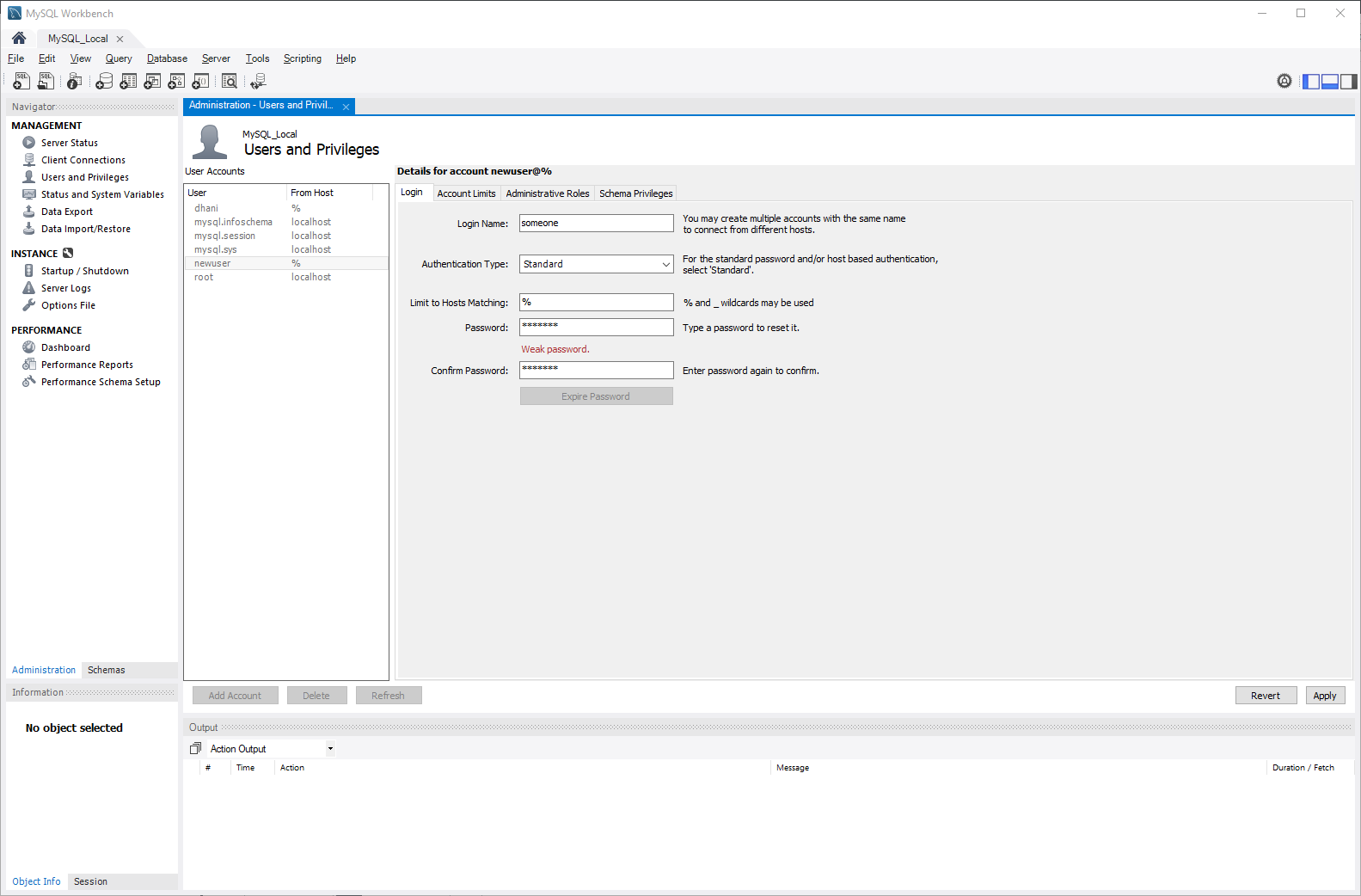

- #CREATE USER MYSQL WORKBENCH HOW TO#
- #CREATE USER MYSQL WORKBENCH INSTALL#
- #CREATE USER MYSQL WORKBENCH SOFTWARE#
- #CREATE USER MYSQL WORKBENCH PASSWORD#
- #CREATE USER MYSQL WORKBENCH DOWNLOAD#

MySQL Workbench possesses tools that allow database administrators to virtually create physical database design models that can be easily transitioned into MySQL databases using forward engineering.MySQL Workbench - Modeling and Designing Tool MySQL Workbench offers a forward engineering model to a script/live database.MySQL Workbench provides reverse engineering for live databases to models.You can create a Graphical Model using MySQL Workbench.It also offers a graphical interface to work with the databases in a structured way. MySQL Workbench provides data modeling, SQL development, and various administration tools for configuration. MySQL Workbench is a unified cross-platform, open-source relational database design tool that adds functionality and ease to MySQL and SQL development work. Now, you will see what MySQL Workbench exactly is and how one can use it. With this, it is clear why MySQL is used. MySQL runs on Windows, Linux, and macOS because of its cross-platform property. The community edition of MySQL is free of cost, and the commercial edition has a licensing fee, which is cost-effective compared to other products available in the market. MySQL has reported high performance compared to other database management systems because of its simplicity in design, and adherence to multiple storage engines. It does not support ACID-based transactions. MyISAM: Former to version 5.5, MyISAM was the default storage engine used by MySQL.InnoDB: It is the default storage engine fabricated with MySQL since version 5.5.MySQL adheres to multiple storage engines, and each one of the storage engines possesses unique features, while other databases like SQL Server only support a single storage engine. Here are some reasons why people use MySQL over other Database Management Systems. Click Save Changes to complete your new user setup.There are various relational database management systems present in the tech world today, such as Microsoft SQL Server, Microsoft Access, Oracle, DB2, etc.
#CREATE USER MYSQL WORKBENCH SOFTWARE#
Most modern website software will only require the permissions listed below. Select the appropriate privileges to allow the user access to the selected database. Select the Selected Schema radio option, and choose your database schema from the list. Click the user account from the list of users on the left. To assign privileges for this user to access a specific database, click on the Schema Privileges tab. Click Apply to create the new user account.
#CREATE USER MYSQL WORKBENCH PASSWORD#
Enter a login name for the new user, type localhost and a new password as shown. Click on your MySQL server instance under the Server Administrator section of MySQL workbench to create a new database user and assign privileges to your new database.Ĭlick on Users and Privileges. Your database should now be listed on the left with your other database schemas.Ĭlick the Home icon in the top left corner to return to the Workbench Central screen. Click the Apply button to generate the SQL script.Ĭlick the Apply button again to execute the create database statement, and create your new database. Enter your root or user and password that has been assigned dba server privileges.Ĭlick on the New Schema icon in the menu, and then enter a name for your new database in the field as shown. MySQL workbench may require a login to your MySQL server. NOTE: Databases are called schema's in MySQL Workbench.
#CREATE USER MYSQL WORKBENCH DOWNLOAD#
To download the latest version click here.ĭOUBLE-Click on your MySQL instance under the SQL Development section of Workbench to create a new schema.
#CREATE USER MYSQL WORKBENCH HOW TO#
This tutorial illustrates how to create a new database and a new user to access that database on a MySQL Server using phpMyAdmin.
#CREATE USER MYSQL WORKBENCH INSTALL#
MySQL workbench is a windows GUI software agent used to administrate MySQL servers and databases, and is often installed by default on a windows server running MySQL, however you can also install it remotely on a client or developer machine.


 0 kommentar(er)
0 kommentar(er)
